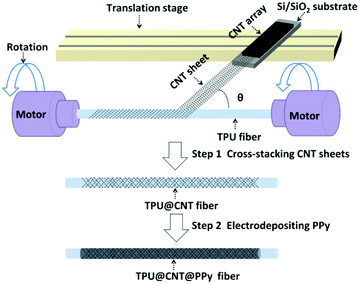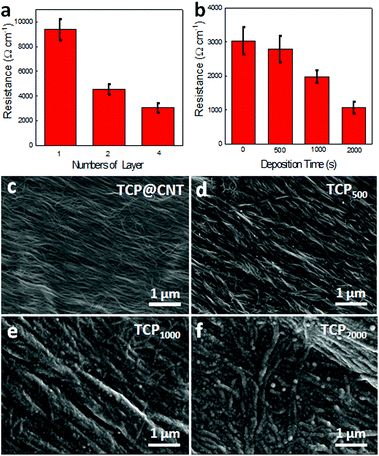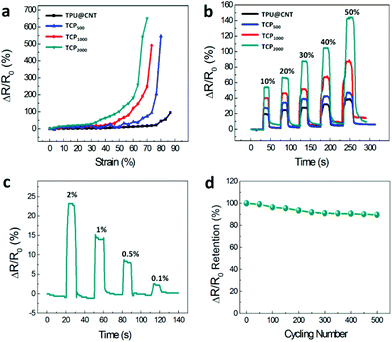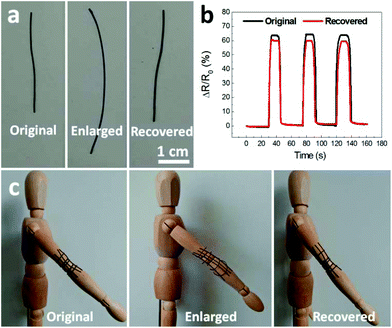Design of a wearable and shape-memory fibriform sensor for the detection of multimodal deformation†
Li
Li
a,
Peipei
Shi
a,
Li
Hua
a,
Jianing
An
b,
Yujiao
Gong
a,
Ruyi
Chen
a,
Chenyang
Yu
a,
Weiwei
Hua
a,
Fei
Xiu
a,
Jinyuan
Zhou
 c,
Guangfa
Gao
d,
Zhong
Jin
c,
Guangfa
Gao
d,
Zhong
Jin
 e,
Gengzhi
Sun
e,
Gengzhi
Sun
 *a and
Wei
Huang
*af
*a and
Wei
Huang
*af
aKey Laboratory of Flexible Electronics (KLOFE) & Institute of Advanced Materials (IAM), Jiangsu National Synergetic Innovation Center for Advanced Materials (SICAM), Nanjing Tech University (NanjingTech), 30 South Puzhu Road, Nanjing 211816, P. R. China. E-mail: iamgzsun@njtech.edu.cn; iamwhuang@njtech.edu.cn
bSchool of Mechanical and Aerospace Engineering, Nanyang Technological University, 50 Nanyang Avenue, 639798, Singapore
cSchool of Physical Science and Technology, Lanzhou University, 222 South Tianshui Road, Lanzhou 730000, P. R. China
dSchool of Mechanical Engineering, Nanjing University of Science and Technology, 200 Xiao Ling Wei, Nanjing 210094, P. R. China
eKey Laboratory of Mesoscopic Chemistry of MOE, School of Chemistry and Chemical Engineering, Nanjing University, 163 Xianlin Avenue, Nanjing 210023, P. R. China
fShannxi Institute of Flexible Electronics (SIFE), Northwestern Polytechnical University, 127 West Youyi Road, Xi'an 710072, P. R. China. E-mail: iamwhuang@njtech.edu.cn
First published on 22nd November 2017
Abstract
A wearable and shape-memory strain sensor with a coaxial configuration is designed, comprising a thermoplastic polyurethane fiber as the core support, well-aligned and interconnected carbon nanotubes (CNTs) as conductive filaments, and polypyrrole (PPy) coating as the cladding layer. In this design, the stress relaxation between CNTs is well confined by the outer PPy cladding layer, which endows the fibriform sensor with good reliability and repeatability. The microcracks generated when the coaxial fiber is under strain guarantee the superior sensitivity of this fibriform sensor with a gauge factor of 12 at 0.1% strain, a wide detectable range (from 0.1% to 50% tensile strain), and the ability to detect multimodal deformation (tension, bending, and torsion) and human motions (finger bending, breathing, and phonation). In addition, due to its shape-memory characteristic, the sensing performance of the fibriform sensor is well retained after its shape recovers from 50% deformation and the fabric woven from the shape-memory coaxial fibers can be worn on the elbow joints in a reversible manner (original-enlarged-recovered) and fitted tightly. Thus, this sensor shows promising applications in wearable electronics.
Introduction
As an important subfield of smart textiles, wearable strain sensors with high sensitivity, wide detection range, and ability to detect multimodal deformations have attracted significant interest due to their potential applications in electronic skins, motion capture, personal protection, and health care.1–4 Although conventional strain gauges based on metallic materials exhibit high sensitivity due to the micro/nano-cracks generated under tiny strain, they severely suffer from poor mechanical compliance and a narrow sensing range (normally less than 5% strain), making them incompetent for use in wearable electronics.5To overcome the aforementioned drawbacks, alternative nanostructures such as metal nanowires,6,7 graphene,8–11 and carbon nanotubes (CNTs)12–14 have been adopted as newly developed sensing materials. Among these candidates, CNTs are preferred for the fabrication of high-performance strain sensors due to their one-dimensional structure, superior mechanical strength, low electrical resistivity, and ability to form conductive networks.15 Moreover, one of the widely utilized approaches is to incorporate CNTs into a rubbery matrix through a solution blending method.16 When the sensor is subjected to mechanical deformation, the interconnection between CNTs in the matrix changes; this provides a responsive signal with respect to electrical conductance. However, one unresolvable issue lies in obtaining a good dispersion of CNTs, which determines the sensing performance of the resulting devices.17 Besides, the incorporation of CNTs into the polymer matrix inevitably increases the stiffness of the composite and thereby narrows the sensing range of the device.18–20 Another strategy is to deposit pre-formed CNT networks, e.g., interconnected CNT sheets, on top of an elastomer substrate.21 The interconnection between CNTs in such sheets primarily arises from weak van der Waals forces.22–25 However, under conditions of large strain or repetitive loading-unloading cycles, the as-fabricated sensors exhibit poor stability and repeatability, as well as inferior sensitivity to small deformation, due to the sliding between CNTs as a result of stress relaxation.21 In addition, the majority of precedent strain sensors are incapable of sensing multimodal deformations (e.g., stretching, bending and twisting) simultaneously, which hinders their application in the detection of complex body movements.26 Furthermore, most of the reported strain sensors are built on planar substrates, which make them unable to be tightly fitted onto complex/irregular three dimensional (3D) architectures, such as elbow joints and knee joints. This poses problems in electronic sensing of the dynamic motions of the human body.26
Herein, for the first time, we develop a shape-memory fiber sensor with a coaxial configuration consisting of thermoplastic polyurethane (TPU) fiber as the core-support, well-aligned CNTs as conductive filaments, and polypyrrole (PPy) coating as the cladding layer. In this design, the stress relaxation between CNTs is well confined by the outer PPy layer, which endows the fibriform sensor with good reliability and repeatability. On the other hand, the microcracks generated when the coaxial fiber is under strain guarantee the fibriform sensor high sensitivity, superior detection limit and wide detectable range for multimodal deformations (tension, bending, and torsion) and human motions (finger bending, breathing and phonation). Owing to its shape-memory characteristic, the fibriform sensor maintains good sensing properties after its shape recovers from 50% deformation to the original state. As a proof-of-concept application, a fabric is further woven from the shape-memory coaxial fibers, which is worn and fitted tightly on the elbow joints in a reversible manner (original-enlarged-recovered).
Results and discussion
The fabrication of the shape-memory fibriform sensor is schematically illustrated in Fig. 1. The spinnable vertically-aligned CNT array with a thickness of ∼300 μm (Fig. S1†) was prepared through chemical vapor deposition (CVD) according to our previous studies.27–33 The TEM image (Fig. S2†) shows that the CNTs have a mean diameter of 10 nm with multi-walls. In the Raman spectrum of the CNTs (Fig. S3†), there are two characteristic peaks at 1350 cm−1 and 1580 cm−1, which correspond to the D and G band, respectively. The G/D radio is about 1.05, which indicates high-quality CNTs.28 Due to the unique interconnection between the CNTs in the array,22–25 a well-aligned CNT sheet (Fig. S1b†) was continuously pulled out and cross-stacked on TPU fiber at an angle of 80° between the pulling direction of the CNT sheet and the axis of the TPU fiber (Fig. S4†) to obtain the TPU@CNT fiber (Step 1). Subsequently, a thin layer of PPy was electrochemically deposited on the outer surface of the TPU@CNT fiber to form the TPU@CNT@PPy (TCP) fiber (Step 2).The conductance of the TPU@CNT fiber and TCP fiber can be facilely tuned by the number of CNT layers and electrochemical deposition time. The well-aligned characteristic of the CNT sheet gives it high conductivity.32 As the number of cross-stacked CNT layers increases, the specific length resistance decreases from 9.4 kΩ cm−1 for the TPU@CNT fiber with one CNT layer to 3.0 kΩ cm−1 for the TPU@CNT fiber with four CNT layers (Fig. 2a). The outermost PPy coating was achieved by electrochemical deposition at a constant potential of 0.8 V. It is found that the resistance of the TCP fiber decreases with the deposition of PPy in a time dependent manner (Fig. 2b). The morphology change in the resultant hybrid fibers with respect to deposition time was characterized using scanning electron microscopy (SEM). It can be clearly observed that on the surface of the TPU@CNT fiber, the CNTs are well-aligned in the same orientation (Fig. 2c). In comparison, the surface morphology of the TCP fiber changes gradually and the surface coating becomes thicker when the deposition time increases from 0 to 2000 s (Fig. 2d–f). Ultimately, a coralline-like structure was formed on the surface of the TCP fiber with 2000 s deposition of PPy (denoted as TCP2000 fiber, as shown in Fig. 2f). In the cross-sectional SEM image (Fig. S5†), the coaxial structure can be observed clearly.
The strain sensing performance of the TCP fiber was tested by measuring its relative resistance variation (ΔR/R0, where ΔR = R − R0, and R0 and R are the resistance of TCP fiber before and after deformation, respectively) upon stretching. Compared to the TPU@CNT fiber, the TCP fibers exhibited higher sensitivity to tensile strain with a slightly compromised detectable range (Fig. 3a). Specifically, the maximum sensitivity was obtained with the TCP2000 fiber within the strain of 60%, over which ΔR/R0 increases dramatically. This phenomenon can be attributed to the peeling-off of the PPy layer (Fig. S6†) which leads to a rapid increase in fiber resistance and ultimate failure of the fiber sensor. Therefore, unless otherwise specified, the TCP2000 fiber was used for the following studies within the strain range of 0–50%. The sensing capability of the TCP2000 fiber to stepwise tensile strain was examined in Fig. 3b. The ΔR/R0 value of the TCP2000 fiber upon stretching from 10% to 50% was measured to be 55% to 150%, respectively, which is much higher than that of the TPU@CNT fiber. As a demonstration of direct visual observation, both the TPU@CNT and TCP2000 fibers were used as conductive wire to light an LED. Compared to the that connected to the TPU@CNT fiber, the LED connected to the TCP2000 fiber exhibited a more obvious change in brightness when the fiber was subjected to 50% strain (Fig. S7†), which indicating its superior sensitivity to large tensile strain. Besides, the TCP2000 fiber sensor also shows the capability for the detection of tiny strain. The detection limit of the fiber sensor was determined by applying a gradually diminishing step strain (Fig. 3c). The ΔR/R0 value in response to the tiny strain of 0.1% was measured to be 1.2%, giving a gauge factor (GF) of 12, where GF is defined as (ΔR/R0)/ε (ε is the strain). This high detection limit makes the TCP2000 fiber sensor superior to the planar sensors devised using aligned single-walled CNT films on poly(dimethylsiloxane) (PDMS),14 hybridized films of CNT and graphene on PDMS,34 and highly-oriented CNT fiber on PDMS.13 It is also comparable to that of the sensor based on graphene woven fabrics on PDMS.35 In addition, these stepwise tensile testing results within the strain range of 0.1% to 50% (Fig. S8†) are in good agreement with that shown in Fig. 3a, which suggest the good repeatability of the TCP2000 fiber. Moreover, under cyclic tensile tests within 50% strain, the TCP2000 fiber sensor shows good durability and stability with ΔR/R0 retention maintained above 90% after 500 loading-unloading cycles (Fig. 3d), which is of critical importance for practical applications.
The microstructures of the TPU@CNT fiber and TCP2000 fiber during the tensile test were characterized via SEM (Fig. 4a–f). In the case of the TPU@CNT fiber in its original state, the CNTs are wound on TPU with good alignment (Fig. 4a). When the TPU@CNT fiber was subjected to 50% tensile strain, the CNTs became electrically disconnected (Fig. 4b) leading to an increase in fiber resistance. Due to the irreversible sliding between CNTs under stretching,22 the CNTs became wavy even when the TPU@CNT fiber was released to its original state (Fig. 4c), which explains its poor sensitivity and reliability. In comparison, with the presence of the PPy coating on the CNT film as a cladding layer (Fig. 4d), when the TCP2000 fiber is under tension, microcracks are generated and the conductive filaments (CNTs) are well confined by the PPy layer (Fig. 4e). Once the applied strain is released, the microcracks are closed and the electrical connection between the CNTs is retained perfectly (Fig. 4f). Therefore, the superior sensing performance of the TCP2000 fiber (compared to that of the TPU@CNT fiber) can be attributed to the coaxial design with the assistance of the PPy coating (Fig. 4g).
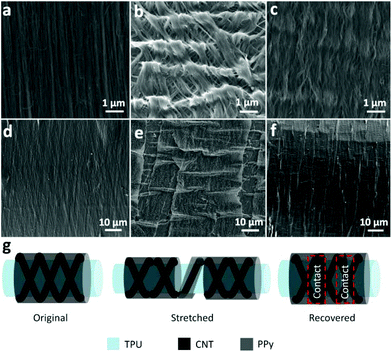 | ||
| Fig. 4 SEM images of (a–c) TPU@CNT fiber and (d–f) TPC2000 fiber in its original, 50% stretched, and released states, respectively. (g) Schematic illustration of the sensing mechanism. | ||
To demonstrate the potential of the TCP2000 fiber as a wearable sensor for the detection of human activity, the fiber sensor was fixed onto the index finger and the electrical signal of ΔR/R0 was recorded in real time when the finger was gradually bent (Fig. 5a). Apparently, the increased bending magnitude leads to a steadily increased electrical response. For capturing subtle physiological signals, the wearable sensors were attached to the chest and throat. The time interval and peak amplitude in the electrical signals are presented in Fig. 5b, which were measured in the relaxation and respiration states and reflect the respiration rate and depth, respectively. Due to the complicated vocal cord vibration and muscle movements around the throat during phonation, when the tester spoke different words, such as “Hi”, “Hello”, and “Sensor”, the response curves exhibited remarkably different characteristics with good repeatability (Fig. 5c). This indicates that the TCP2000 fiber sensor has potential applications in speech rehabilitation training and intelligent speech recognition.36 For sophisticated motion capture, torsion is another vital mechanical deformation in human joints and artificial muscles.37 Benefitting from the symmetrical structure of the CNT@PPy network, the TCP2000 fiber is capable of sensing torsion in both counterclockwise and clockwise directions at different angles with high reproducibility (Fig. 5d), which further broadens its applications in wearable electronics.
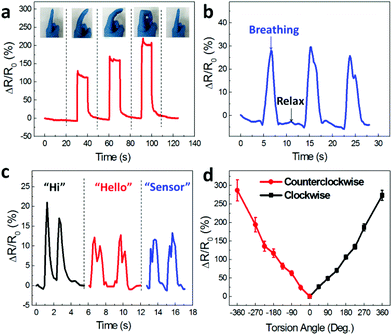 | ||
| Fig. 5 Responsive signal of the TCP2000 fibriform sensor in situ monitoring (a) finger bending, (b) human breathing, (c) phonation, and (d) torsion at different angles. | ||
Generally, strain sensors constructed on planar substrates have only a simplex shape, which is difficult to be applied on a subject with a complex structure.26 For instance, in practical applications, sensing devices are normally required to be fixed onto different parts of the body, e.g., finger, elbow joint, and chest. Therefore, it is highly desirable to design a sensing system that can readily and tightly accommodate its shape to any complex structure in addition to the commonly used planar surface in lab testing. Fortunately, the shape-memory TCP fiber sensor developed in this study can be programmed into a variety of shapes to be adapted to different working conditions. As shown in Fig. 6a, the TCP2000 fiber was deformed and shaped with increased radii of curvature under external bending stresses at a temperature above the glass transition temperature (Ttrans).38 After cooling to room temperature, the polymeric network of the TPU core fiber was physically cross-linked to maintain the enlarged shape.39 Upon heating at a temperature equal to or beyond Ttrans, the TCP2000 fiber fully recovered to its original state due to the cleavage of the physical crosslinks in TPU. The sensing properties of the TCP2000 fiber sensor and that after the shape-memory process from 50% deformation remain almost the identical (Fig. 6b), which suggests good reliability for potential practical applications. As a proof-of-concept demonstration, the textile woven from TCP2000 fibers can be reversibly adapted into different user-required shapes and sizes, and fitted tightly to the elbow joint, as shown in Fig. 6c.
Conclusions
In summary, we developed a fibriform strain sensor that possesses the desirable integration of high sensitivity, broad detection range in strain, superior detection limit, and the capability of sensing multimodal mechanical deformations (tension, bending, and torsion) and monitoring human motions (finger bending, breathing and phonation). In addition, the fibriform sensor shows shape-memory characteristics enabling its fabric to be tightly-fitted to a nonplanar irregular subject, which has not been achieved by the planar strain sensors reported thus. The facile, low-cost, and dry-state fabrication process, as well as the unique coaxial architecture indicate that our fiber sensor is promising for practical applications in electronic skins, motion capture, personal protection, and healthcare.Experimental
Preparation of vertically-aligned CNT arrays
Vertically-aligned CNT arrays were synthesized using a CVD process in a tube furnace.27–33 Typically, the growth was carried out at 750 °C for 10 min using an Fe thin film (1 nm thick) deposited on an Si/SiO2 substrate as the catalyst, and C2H4 and Ar as the carbon source and carrier gas, respectively.Fabrication of TPU@CNT fiber
Commercial TPU fiber (diameter of 500 μm) was used as the core substrate. Two ends of the TPU fiber were fixed to two electric motors, and a CNT array was stabilized on a motorized translation stage. A well-aligned CNT sheet was continuously drawn from the CNT array and wound around the fixed TPU fiber at an angle of 80° between the orientation of the CNT sheet and the axis of the TPU fiber. The two electric motors and the translation stage were operated simultaneously. The winding velocity of the aligned CNT sheet was controlled to be equal to the moving velocity of the translation stage so that the helical angle of the aligned CNT sheet was maintained across the fiber during wrapping.Fabrication of TCP fiber
PPy was electrodeposited onto the TPU@CNT fiber via the electropolymerization of pyrrole at a constant potential of 0.8 V in an aqueous solution containing pyrrole (0.05 M), KCl (0.02 M) and HCl (0.001 M), with Ag/AgCl (saturated KCl) as the reference electrode and platinum plate as the counter electrode.Fabrication of TCP fiber based wearable sensor
The TCP fiber (2 cm in length) was placed onto a PDMS (a 10![[thin space (1/6-em)]](https://www.rsc.org/images/entities/char_2009.gif) :
:![[thin space (1/6-em)]](https://www.rsc.org/images/entities/char_2009.gif) 1 mixture of PDMS prepolymer and curing agent, Sylgrad-184, Dow Corning) thin film. Copper wires (0.2 mm in diameter) were connected to the two ends of the TCP fiber with the help of silver paste for in situ electrical tests.
1 mixture of PDMS prepolymer and curing agent, Sylgrad-184, Dow Corning) thin film. Copper wires (0.2 mm in diameter) were connected to the two ends of the TCP fiber with the help of silver paste for in situ electrical tests.
Characterization and measurement
SEM (JEOL, JSM-7800F) was used to observe the microstructure of the fiber during stretching and after testing. TEM (JEOL-2010) and Raman Spectroscopy (WITEC, Alpha300M+) with a 633 nm laser source were used to characterize the CNTs. A microforce testing system (HY-0350, Shanghai Heng Yi Precise Instrument Co., Ltd) was used to apply constant stress, strain, and displacement to the strain sensor at a loading speed of 20 mm min−1. A digital source meter (Keithley 2400) was used to measure the relative resistance change of the sensor, and the results were recorded on a computer using LabVIEW.Conflicts of interest
There are no conflicts of interest to declare.Acknowledgements
This work was supported by NanjingTech Start-Up Grant (3983500150), Jiangsu Specially-Appointed Professor program (54935012), the Natural Science Foundation of Jiangsu Province (BK20171018) and the National Natural Science Foundation of China (61704076, 11472008 and 11674140).References
- A. Chortos, J. Liu and Z. A. Bao, Nat. Mater., 2016, 15, 937–950 CrossRef CAS PubMed.
- Z. N. Bao, MRS Bull., 2016, 41, 897–902 CrossRef.
- A. Chortos and Z. N. Bao, Mater. Today, 2014, 17, 321–331 CrossRef CAS.
- M. L. Hammock, A. Chortos, B. C. K. Tee, J. B. H. Tok and Z. A. Bao, Adv. Mater., 2013, 25, 5997–6037 CrossRef CAS PubMed.
- J. Park, I. You, S. Shin and U. Jeong, ChemPhysChem, 2015, 16, 1155–1163 CrossRef CAS PubMed.
- S. Lee, S. Shin, S. Lee, J. Seo, J. Lee, S. Son, H. J. Cho, H. Algadi, S. Al-Sayari, D. E. Kim and T. Lee, Adv. Funct. Mater., 2015, 25, 3114–3121 CrossRef CAS.
- R. Ma, B. Kang, S. Cho, M. Choi and S. Baik, ACS Nano, 2015, 9, 10876–10886 CrossRef CAS PubMed.
- F. Zhao, Y. Zhao, H. H. Cheng and L. T. Qu, Angew. Chem., Int. Ed., 2015, 54, 14951–14955 CrossRef CAS PubMed.
- Y. Cheng, R. R. Wang, J. Sun and L. Gao, Adv. Mater., 2015, 27, 7365–7371 CrossRef CAS PubMed.
- Q. Liu, J. Chen, Y. R. Li and G. Q. Shi, ACS Nano, 2016, 10, 7901–7906 CrossRef CAS PubMed.
- C. Y. Yan, J. X. Wang, W. B. Kang, M. Q. Cui, X. Wang, C. Y. Foo, K. J. Chee and P. S. Lee, Adv. Mater., 2014, 26, 2022–2027 CrossRef CAS PubMed.
- J. Foroughi, G. M. Spinks, S. Aziz, A. Mirabedini, A. Jeiranikhameneh, G. G. Wallace, M. E. Kozlov and R. H. Baughman, ACS Nano, 2016, 10, 9129–9135 CrossRef CAS PubMed.
- S. Ryu, P. Lee, J. B. Chou, R. Z. Xu, R. Zhao, A. J. Hart and S. G. Kim, ACS Nano, 2015, 9, 5929–5936 CrossRef CAS PubMed.
- T. Yamada, Y. Hayamizu, Y. Yamamoto, Y. Yomogida, A. Izadi-Najafabadi, D. N. Futaba and K. Hata, Nat. Nanotechnol., 2011, 6, 296–301 CrossRef CAS PubMed.
- D. J. Lipomi, M. Vosgueritchian, B. C. K. Tee, S. L. Hellstrom, J. A. Lee, C. H. Fox and Z. N. Bao, Nat. Nanotechnol., 2011, 6, 788–792 CrossRef CAS PubMed.
- S. Jung, J. H. Kim, J. Kim, S. Choi, J. Lee, I. Park, T. Hyeon and D. H. Kim, Adv. Mater., 2014, 26, 4825–4830 CrossRef CAS PubMed.
- S. Park, M. Vosguerichian and Z. A. Bao, Nanoscale, 2013, 5, 1727–1752 RSC.
- P. D. Bradford, X. Wang, H. B. Zhao, J. P. Maria, Q. X. Jia and Y. T. Zhu, Compos. Sci. Technol., 2010, 70, 1980–1985 CrossRef CAS.
- J. J. Ge, H. Q. Hou, Q. Li, M. J. Graham, A. Greiner, D. H. Reneker, F. W. Harris and S. Z. D. Cheng, J. Am. Chem. Soc., 2004, 126, 15754–15761 CrossRef CAS PubMed.
- Q. F. Cheng, M. Z. Li, L. Jiang and Z. Y. Tang, Adv. Mater., 2012, 24, 1838–1843 CrossRef CAS PubMed.
- F. Xu, X. Wang, Y. T. Zhu and Y. Zhu, Adv. Funct. Mater., 2012, 22, 1279–1283 CrossRef CAS.
- G. Z. Sun, L. X. Zheng, J. Y. Zhou, Y. N. Zhang, Z. Y. Zhan and J. H. L. Pang, Int. J. Plast., 2013, 40, 56–64 CrossRef CAS.
- X. B. Zhang, K. L. Jiang, C. Teng, P. Liu, L. Zhang, J. Kong, T. H. Zhang, Q. Q. Li and S. S. Fan, Adv. Mater., 2006, 18, 1505–1510 CrossRef CAS.
- M. Zhang, S. L. Fang, A. A. Zakhidov, S. B. Lee, A. E. Aliev, C. D. Williams, K. R. Atkinson and R. H. Baughman, Science, 2005, 309, 1215–1219 CrossRef CAS PubMed.
- L. Hua, Z. Y. Ma, P. P. Shi, L. Li, K. Rui, J. Y. Zhou, X. Huang, X. Liu, J. X. Zhu, G. Z. Sun and W. Huang, J. Mater. Chem. A, 2017, 5, 2483–2487 CAS.
- M. Amjadi, K. U. Kyung, I. Park and M. Sitti, Adv. Funct. Mater., 2016, 26, 1678–1698 CrossRef CAS.
- P. P. Shi, L. Li, L. Hua, Q. Q. Qian, P. F. Wang, J. Y. Zhou, G. Z. Sun and W. Huang, ACS Nano, 2017, 11, 444–452 CrossRef CAS PubMed.
- G. Z. Sun, Y. X. Huang, L. X. Zheng, Z. Y. Zhan, Y. N. Zhang, J. H. L. Pang, T. Wu and P. Chen, Nanoscale, 2011, 3, 4854–4858 RSC.
- G. Z. Sun, J. Q. Liu, L. X. Zheng, W. Huang and H. Zhang, Angew. Chem., Int. Ed., 2013, 52, 13351–13355 CrossRef CAS PubMed.
- G. Z. Sun, X. Zhang, R. Z. Lin, B. Chen, L. X. Zheng, X. Huang, L. Huang, W. Huang, H. Zhang and P. Chen, Adv. Electron. Mater., 2016, 2, 1600102 CrossRef.
- G. Z. Sun, X. Zhang, R. Z. Lin, J. Yang, H. Zhang and P. Chen, Angew. Chem., Int. Ed., 2015, 54, 4651–4656 CrossRef CAS PubMed.
- G. Z. Sun, L. X. Zheng, J. An, Y. Z. Pan, J. Y. Zhou, Z. Y. Zhan, J. H. L. Pang, C. K. Chua, K. F. Leong and L. Li, Nanoscale, 2013, 5, 2870–2874 RSC.
- Q. Qian, Q. Hu, L. Li, P. Shi, J. Zhou, J. Kong, X. Zhang, G. Sun and W. Huang, Sens. Actuators, B, 2018, 257, 23–28 CrossRef CAS.
- J. D. Shi, X. M. Li, H. Y. Cheng, Z. J. Liu, L. Y. Zhao, T. T. Yang, Z. H. Dai, Z. G. Cheng, E. Z. Shi, L. Yang, Z. Zhang, A. Y. Cao, H. W. Zhu and Y. Fang, Adv. Funct. Mater., 2016, 26, 2078–2084 CrossRef CAS.
- Y. Wang, L. Wang, T. T. Yang, X. Li, X. B. Zang, M. Zhu, K. L. Wang, D. H. Wu and H. W. Zhu, Adv. Funct. Mater., 2014, 24, 4666–4670 CrossRef CAS.
- D. Kang, P. V. Pikhitsa, Y. W. Choi, C. Lee, S. S. Shin, L. F. Piao, B. Park, K. Y. Suh, T. I. Kim and M. Choi, Nature, 2014, 516, 222–226 CrossRef CAS PubMed.
- J. Foroughi, G. M. Spinks, G. G. Wallace, J. Oh, M. E. Kozlov, S. L. Fang, T. Mirfakhrai, J. D. W. Madden, M. K. Shin, S. J. Kim and R. H. Baughman, Science, 2011, 334, 494–497 CrossRef CAS PubMed.
- M. Behl, M. Y. Razzaq and A. Lendlein, Adv. Mater., 2010, 22, 3388–3410 CrossRef CAS PubMed.
- J. E. Deng, Y. Zhang, Y. Zhao, P. N. Chen, X. L. Cheng and H. S. Peng, Angew. Chem., Int. Ed., 2015, 54, 15419–15423 CrossRef CAS PubMed.
Footnote |
| † Electronic supplementary information (ESI) available. See DOI: 10.1039/c7nr06219b |
| This journal is © The Royal Society of Chemistry 2018 |

